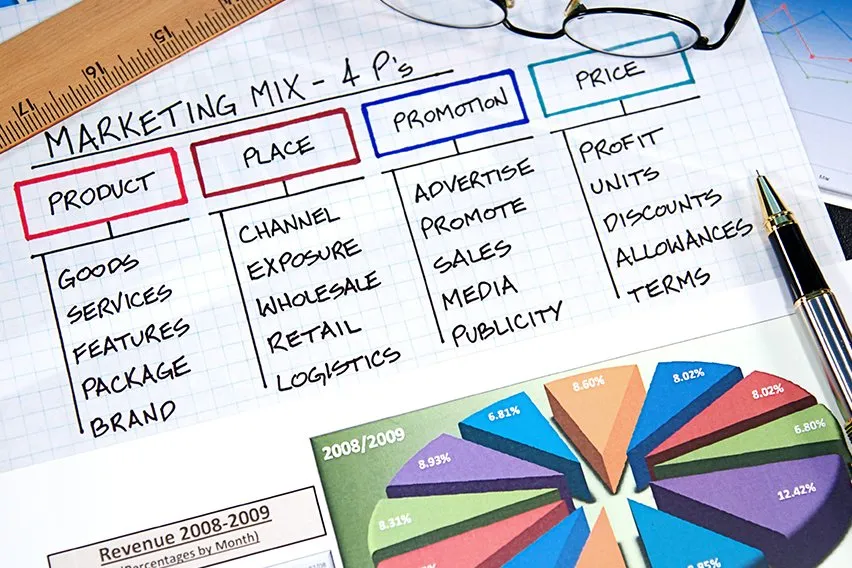What Is Marketing Mix & 4 Ps of Marketing? A Step-By-Step Guide

Simply put, marketing is all about having the right product in the right place. But it also needs to be at the right price and offered to customers at the right time. It sounds easy enough, but there can be a lot of work and research that goes into organizing your marketing mix.
The four Ps of marketing help set the foundation for your marketing strategy. So where do you start? How do you know what you should include? Even if you have the best product or service out there, you still need to have the right strategy in place. You can make better product decisions, promotion decisions and pricing strategies.
Let’s take a closer look at the marketing mix and the 4 Ps of marketing.
Here’s What We’ll Cover:
What Are the 4 Ps of Marketing?
Implementing the 4 Ps of Marketing
What Is a Marketing Mix?
The actions that you take and the tactics that you put into place to get your product or service to market is considered your marketing mix. It’s a great way to help make sure that your product reaches the right destination. Your marketing mix is an important tool to help you understand what your product or service offers and how you can successfully get it to market.
The marketing mix usually consists of the 4 Ps of marketing, which are price, product, promotion and place. This is a great place to begin the planning for your product or service.

What Are the 4 Ps of Marketing?
The 4 Ps of marketing set the foundation for successfully getting your product or service to market. They take into account your business environment, including any internal or external factors. Plus, the 4 Ps interact with each other almost interchangeably.
They help you to identify key factors, such as what your customers want from you and how your product or service can meet their needs. As well, the 4 Ps also identify how your product or service is going to get perceived and how it stands out compared to your competitors.
How Do the 4 Ps Work?
It’s worth noting that every successful marketing strategy evolves over time. The details in your first marketing mix aren’t meant to be static, but rather refined and adjusted. And this can happen as your product or service grows or if your customer’s buying habits change.
Product
This is exactly how it sounds: it’s all about your product. But, it’s not enough to simply have a product. You need to have a product that fulfils an existing consumer demand. Or, your product might be so good and so compelling that it creates a new demand within the market.
To be successful in your product strategy, you must understand your product’s life cycle and have a plan for each stage of the life cycle. Your product’s features and benefits need to be understood and your potential customers need to get identified.
Here are a few questions you can ask yourself to understand the product element:
- What do your customers want from your product or service?
- What features does your product offer?
- Where and how are your customers going to use your product?
- What is the product called and how is it branded?
- Is your product different compared to your competitors? How so?
Price
The price is how much you are going to charge your customers for your product. And how you price your product can have a significant impact on how well it sells. For example, if a product gets priced differently than its perceived value, it likely won’t sell.
So, it’s incredibly important to fully understand your customer base and how they perceive what it is that you’re selling. The price can also get affected by value chain costs, distribution plans and markups. Plus, you need to keep an eye on how your competition is pricing their products.
Here are a few questions you can ask yourself to understand the price element:
- How will your customers perceive the value of your product?
- Are there any already established price points for similar products in your market?
- If you make a small decrease in your price, can you gain market share?
- Should you offer any discounts to trade customers or other market segments?
- How is your price going to compare to your competition?
Place
When it comes to place, this has to do with how and where you will provide your product to your customers. Throughout this process, you can assess which sales channel might be best suited for your product. Basically, you’re trying to determine where you should sell your product and how to get it to market.
Some placement strategies refer to where your product gets placed in a store. Others might refer to advertising spots on television shows, in films or across the internet. This is to help generate as much attention as possible for the product.
Here are a few questions you can ask yourself to understand the place element:
- Where are your customers most likely going to search for your product?
- Will it be in a specialist boutique or a supermarket? What about only online or in a catalogue?
- What are your competitors doing? What can you learn from them to differentiate your product?
- Do you have access to the proper distribution channels?
Promotion
How are you going to let your customers know about your product or service? Do you have an advertising strategy in place? What about sales promotions, special offers or public relations? Whatever channel or route that you take needs to be suitable for the product that you’re offering.
Promotional strategies also need to be suitable for the price of your product and the customer base you’re marketing to.
Here are a few questions you can ask yourself to understand the promotion element:
- Where are you going to implement your advertising or marketing messages? How are you going to get those messages in front of your target market?
- Are you going to advertise online, on TV, on the radio or in the press? What about online marketing campaigns or a distribution strategy?
- Is there any seasonality within your market? When is the best and most optimal time to promote your product?
- Are there any environmental issues that can delay the timing of your product launch or any other promotions?
- What is your competition doing to promote their product? Is it going to influence how you move forward with promotional activities?
Implementing the 4 Ps of Marketing
It’s one thing to understand what needs to get included in your marketing mix, but it can be another thing to implement a strategy. Below you will find some steps that you can follow to help define and improve your overall marketing mix.
First, start by identifying the product that you’re going to analyze. Once you have done that, you can move on to the 4 Ps. Go through and answer some of the questions listed above to help set your foundation.
If you’re having some trouble answering some of the questions, you can ask yourself some questions to help. For example, why does your target audience need the features that your product offers? Or, if you lower your price by $5, will that have a positive or negative effect?
Once you have defined what will get included in your marketing mix you can try and test some of the details. Put yourself in your customer’s shoes and ask yourself some questions surrounding the 4 Ps.
- Does your product meet your customer’s needs?
- Are you customers going to find your product in the place that they shop?
- Will your customers see the price as favourable?
- Do you have the right promotions in place to make sure that you reach your customers?
One of the best things that you can do when developing your marketing mix is ask a ton of questions. This helps you to make sure that your marketing mix is as optimized as possible. Plus, some elements are going to change as you move forward. Adapting and evolving in a competitive marketing landscape is critical as your product grows.

Key Takeaways
Marketing mix and the 4 Ps of marketing are often one-in-the-same. They’re key elements that are involved in marketing your product or service and they interact with each other. But, sometimes the 4 Ps can get known as the 4 Cs of marketing.
The 4 Cs were developed as an alternative to the 4 Ps because they put a greater focus on the customer instead of the marketer. The 4 C’s would look like this:
- Customer wants and needs
- Cost to the customer
- Convenience to the customer
- Communication to the customer
You can see that the 4 Cs are very similar to the 4 Ps, they’re just more customer-focused. There isn’t one strategy that works better than the other, it just depends on the type of product or service that you offer.
The 4 Ps of marketing help to build the foundation for getting your product or service to market. They take into account internal and external factors and each of the 4 Ps work interchangeably. One of the biggest challenges to successfully getting a product to market is understanding what your customers want.
The 4 Ps help to identify how your product will get perceived and how it can stand out compared to your competition. Take some time to answer the questions outlined above for product, place, price and promotion. You can make sure that you put the right product in the right place, make better marketing decisions and increase your loyal customers.
Did you enjoy reading this guide? Head over to our resource hub for more great content!
RELATED ARTICLES

 T1 Vs T4 Tax Form: What’s the Difference?
T1 Vs T4 Tax Form: What’s the Difference? Is PayPal Safe for Sellers & Buyers? 7 Security Tips to Protect
Is PayPal Safe for Sellers & Buyers? 7 Security Tips to Protect 12 Best Business to Start in Canada
12 Best Business to Start in Canada What Is Financial Planning and Analysis (FP&A)? A Guide
What Is Financial Planning and Analysis (FP&A)? A Guide Market Expansion Strategy: A Complete Business Guide
Market Expansion Strategy: A Complete Business Guide Target Market Analysis: What It Is & How to Analyze It?
Target Market Analysis: What It Is & How to Analyze It?